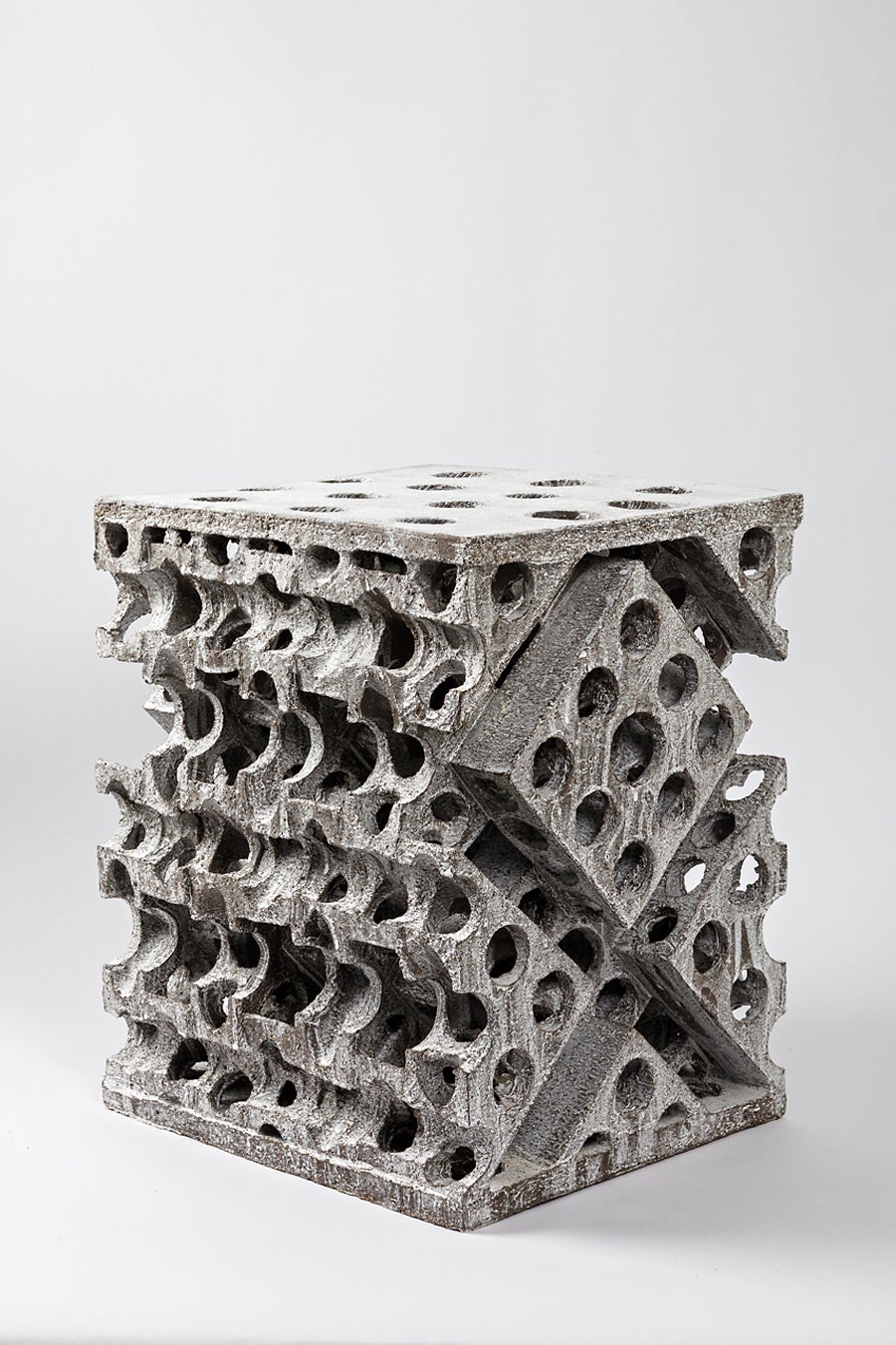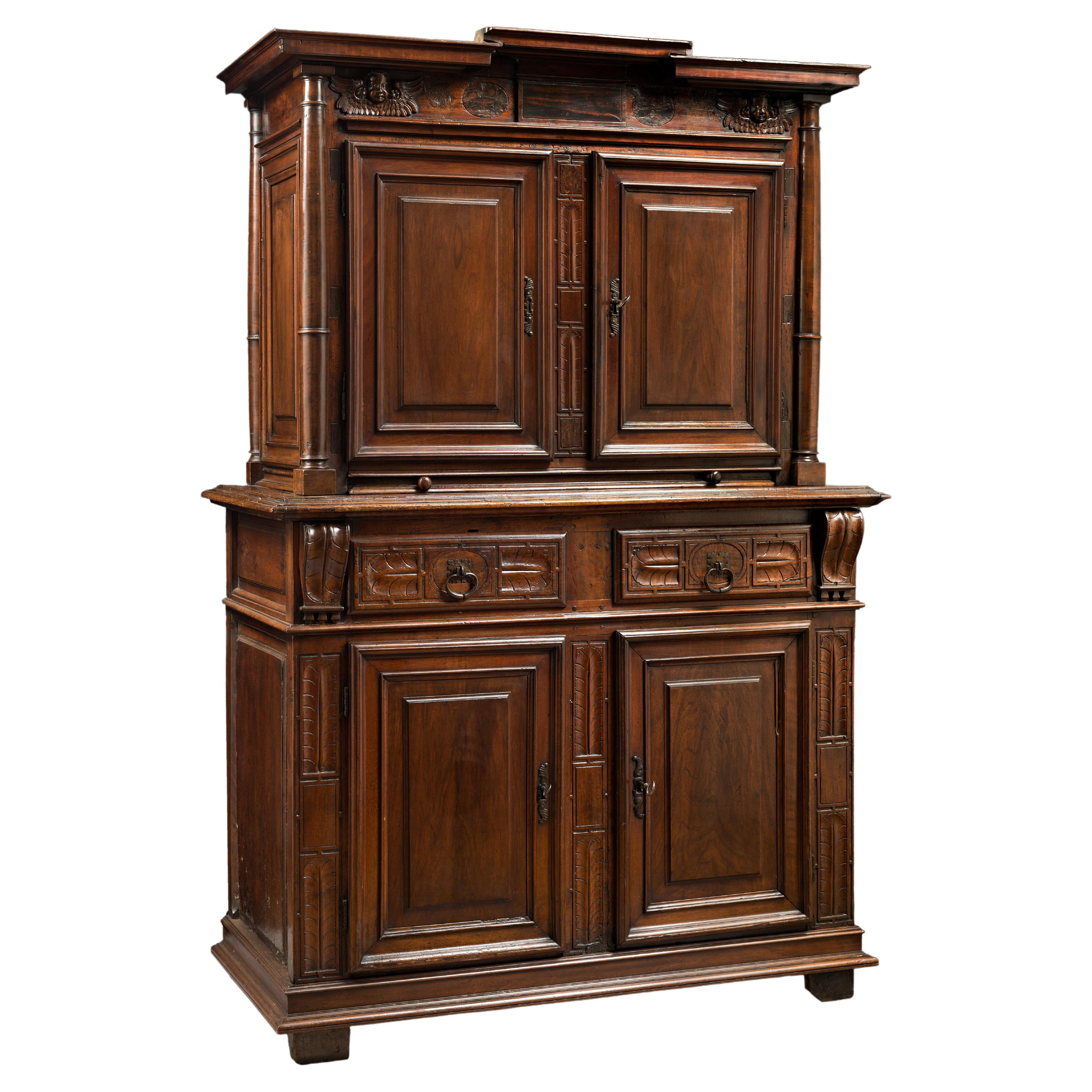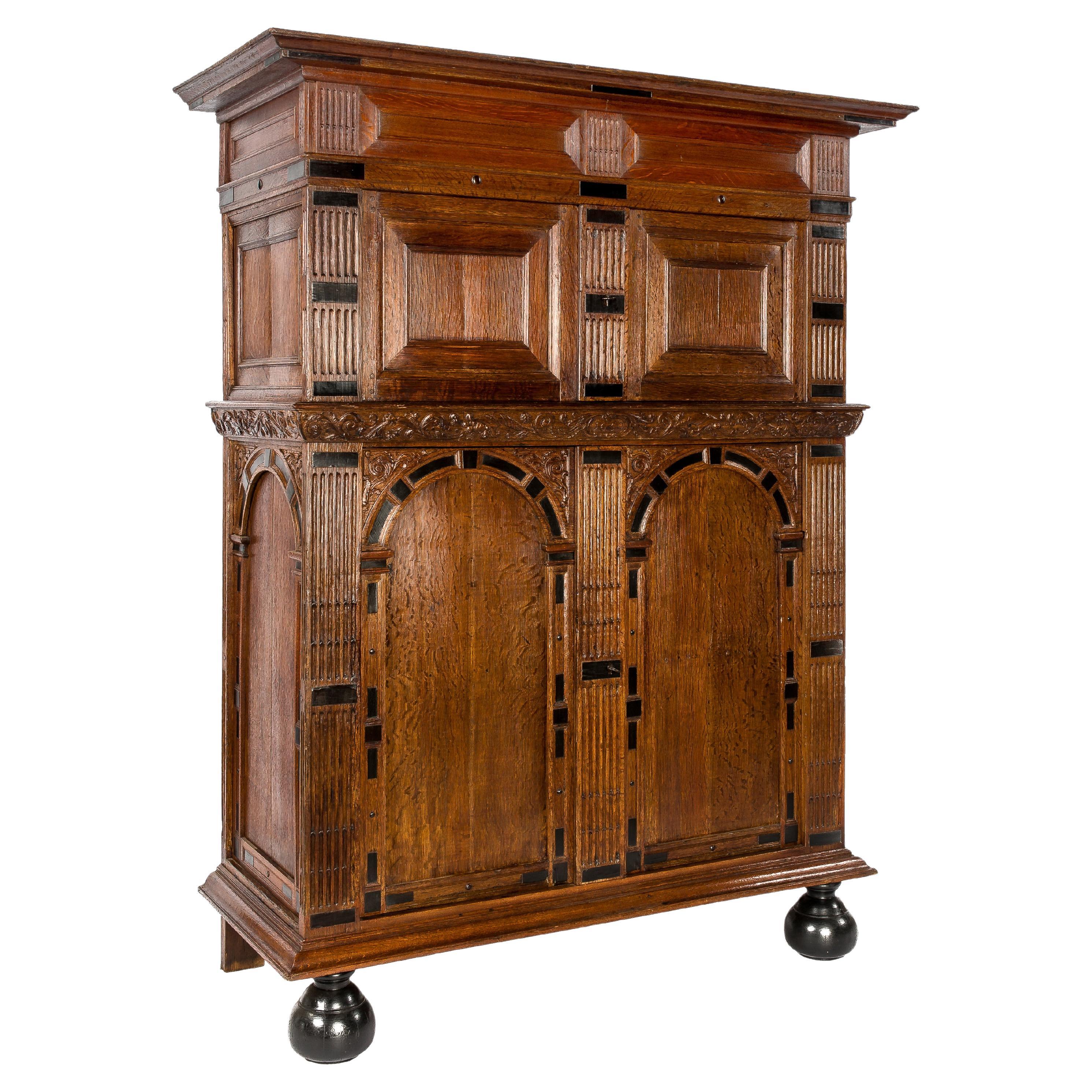Items Similar to Burgundian Renaissance Cabinet Depicting the Four Evangelists
Want more images or videos?
Request additional images or videos from the seller
1 of 9
Burgundian Renaissance Cabinet Depicting the Four Evangelists
About the Item
The cabinet’s upper body, slightly recessed is topped by an overlapping entablature and cornice supported both in the front and the rear by four fluted columns.
The lower body stands on four squared feet and a moulded base. Each door-leaf’s panel is centred by a low-relief carving presenting one of the four evangelists, wearing a draped cloak, inside an oval frame. This composition is surrounded by delicate vegetal motifs. On the right hand side, the youngest evangelist, John, is depicted beardless, a halo over his head. Holding a quill John is writting his gospel under a tree, accompanied by the eagle. On the opposite side, Luke is also depicted working on his gospel with a bull by his sides. The lateral and central posts are adorned with fruit garlands, draperies and masks.
Mouldings carved with rose motifs frame the belt. Two drawers are centred by a finely carved lion face surrounded by fruits and draperies. These drawers are flanked by two feathered masks and a shield on a cut-out leather.
The upper body is punctuated by two male terms and a female one in the centre. The drapery of the latter hides the keyhole. In the same manner as the lower body the door-leaves present the two other evangelists. Saint Mark and his lion on the right hand side panel face Saint Matthew and the angel on the left hand side.
The cabinet’s lateral sides present a rich ornamentation too. The upper body’s panels present a symmetrical vegetal composition in a flat-work low-relief spreading around a high-relief mask. Feather quills and palm leaves flank the composition. The lower body’s panel bears a flower decor with four leaves. On the belt a small flower is accompanied by two feather quills. The cabinet is topped by a cornice supported by palm leaves modillions.
This piece of funiture expresses the new interest patrons had for religious subjects during this period. The Old and New Testament have been a great source of inspiration for cabinet-makers. Therefore, today, this production is hard to attribute to clerical of profane use. We can find many examples in Picardy or in Western France and Languedoc. While the Old Testament have always been particularly favoured, the Counter Reform enhanced the depiction of characters from the New Testament. From the 16th century onwards Christ, the Virgin Mary, the four Evangelists, the twelve apostles are more commonly represented.
For this reason our cabinet might have furnished the house of an ecclesiastic as well as a profane but pious and rich family. The four symbols attributed to the writers of the Gospels, the Tetramorph, originates from the vision of Ezekiel (Ez ; 1,1-28) and the Apocalypse (Ap ; 4,1-11).
Because of its decor, the variety of motifs and its quality of execution this cabinet is an exceptional piece. The delicacy and refinement of the carvings express the work of a skilled cabinet-maker. The use of the flat-work carving, echoing the engraving industry, is characteristic of the school of Lyon around 1540-1570.
Literature
JAQUES THIRION, Le mobilier du Moyen-Age et de la Renaissance en France, Edition Faton, 1998.
- Dimensions:Height: 66.54 in (169 cm)Width: 59.85 in (152 cm)Depth: 22.45 in (57 cm)
- Style:Renaissance (Of the Period)
- Materials and Techniques:
- Place of Origin:
- Period:
- Date of Manufacture:16th Century
- Condition:Repaired.
- Seller Location:Saint-Ouen, FR
- Reference Number:1stDibs: LU3115327267432

About the Seller
5.0
Vetted Seller
These experienced sellers undergo a comprehensive evaluation by our team of in-house experts.
Established in 2016
1stDibs seller since 2017
156 sales on 1stDibs
Typical response time: 8 hours
- ShippingRetrieving quote...Ships From: Saint-Ouen, France
- Return PolicyThis item cannot be returned.
More From This SellerView All
- 16th Century Renaissance Two-Bodied CabinetLocated in Saint-Ouen, FRFormer collection Altounian At the beginning of the reign of Henri II (1547-1559) the furniture’s ornamentation evolves. The few medieval motifs that were still used are eventually relinquished. Furniture becomes more sober showcasing moulded panels and perfect architecture. Cabinet-makers use ornaments such as curved fluted or plain columns, feather quills, roses or winged putti heads. High-relief carving becomes more scarce and compositions lighter. To that end cabinet-makers draw inspiration from Fontainebleau motifs filtering them and adapting them to French taste. During this period cabinet-makers turn into a kind of architects. Indeed the architectural balance of furniture is the centre of their concerns. The study of Antic formulas is then a necessity. From this care given to proportions appear refined cabinets with pure lines. This style is characteristic of the reign of Henri II and disappears soon after under the regency of Catherine de Medici (1560-1574) when an abundance of high and low-relief ornaments comes back on furnitures. This two-bodies cabinet...Category
Antique 16th Century French Renaissance Cabinets
MaterialsWalnut
- 16th Century French Carved Renaissance CabinetLocated in Saint-Ouen, FRRare carved Renaissance cabinet Period : 2nd half 16th century, ca. 1570 Origin : France, Burgundy or Languedoc This cabinet embody the produ...Category
Antique 16th Century French Renaissance Cabinets
MaterialsWalnut
- Renaissance Cupboard from Loire Valley, 'France'Located in Saint-Ouen, FRThis cabinet is composed of two bodies, the upper one being recessed. The extraordinary proportions are enriched by a mythological and floral carved decor. The Lower body stands o...Category
Antique 16th Century French Renaissance Cabinets
MaterialsWalnut
- Rare Italian Renaissance Perspectives Sideboard with Fan-shaped PedestalLocated in Saint-Ouen, FRRARE ITALIAN RENAISSANCE PERSPECTIVES SIDEBOARD WITH FAN-SHAPED PEDESTAL ORIGIN: TUSCANY, FLORENCE PERIOD: 16th CENTURY Height : 143.5 cm Length : 133 cm Depth : 54 cm Li...Category
Antique 16th Century Cabinets
MaterialsWalnut
- Small Renaissance CabinetLocated in Saint-Ouen, FRSmall renaissance cabinet ORIGIN : FRANCE PERIOD : END OF THE 16th CENTURY Measures: height: 167 cm length: 123 cm depth: 58 cm This small two-part unit with harmonious proportions opens with four front leaves and two belt drawers. It rests on a molded base. The uprights and the central frame of the lower body are adorned with long stylized palmettes. They frame the four leaves on which unfolds a vegetal decoration made of stems and leaves sculpted in symmetry around two mascarons topped with feathers...Category
Antique 16th Century French Renaissance Cabinets
MaterialsWalnut
- French Renaissance Cabinet with PerspectivesLocated in Saint-Ouen, FRThis Renaissance Cabinet reveals the great mastery of the Lyon workshops which are at the origin of its realization. Sculptors and wood-carvers worked here in symbiosis to express an...Category
Antique 16th Century French Renaissance Cabinets
MaterialsWalnut
You May Also Like
- Renaissance CabinetLocated in Washington, DCA truly stunning cabinet with a rich patina. Made by a Swedish cabinetmaker in the early 19th century. The paint on the inside and the outside is all original. Original hardware includes the hinges, locks, key, straps. Intricate carved paneling.Category
Antique Early 19th Century Swedish Renaissance Cupboards
MaterialsIron
- 17th Century Dutch Renaissance Oak and Ebony Inlay Four-Door Cabinet Dated 1660Located in Casteren, NLThis extraordinary cabinet is made of the finest watered oak in the tradition of the Dutch Renaissance during the “Dutch golden age” It is a four-door cab...Category
Antique Mid-17th Century Dutch Renaissance Cabinets
MaterialsSteel
- French late 16th century Renaissance Walnut Deux-Corps cabinetLocated in Troy, NYBeautiful French Renaissance cabinet in two parts. The top part with two carved doors featuring classical figures opening to an interior fit...Category
Antique 16th Century French Renaissance Cabinets
MaterialsWalnut
- Monumental Hunt Cabinet 19th century carved oak Black Forest French RenaissanceBy Alexander RouxLocated in Ijzendijke, NLRare monumental Hunt style Renaissance Revival cabinet by Alexander Roux 1870 museum quality piece. Carved out of solid oak with numerous rich details...Category
Antique 1860s American Renaissance Cabinets
MaterialsGlass, Oak
- French Renaissance Henry II Late 16th Century Walnut Deux-Corps CabinetLocated in Troy, NYFrench Henry II Deux-Corps cabinet, in two parts. Of linear design and interesting, unusual proportions, the top part with two-doors over two drawers, bottom with two larger drawers ...Category
Antique 16th Century French Renaissance Cabinets
MaterialsWalnut
- Antique Late 17th Century Dutch Renaissance Single-Door Cabinet in Solid OakLocated in Casteren, NLThis elegant single-door cabinet was made in the Southern part of the Netherlands in the late 17th century. It was made in the best quality quarter-sawn oak in the tradition of the Dutch Renaissance during the “Dutch golden age”. The piece is of exceptional quality and was made completely in watered oak...Category
Antique Late 17th Century Dutch Renaissance Cabinets
MaterialsSteel
Recently Viewed
View AllMore Ways To Browse
Furniture In The Renaissance
Old Antique Cabinets
Old Antique Cabinet
Two Over Four
Flowers Cabinet
Cabinet Flower
Flat Four
Recessed Cabinet
Recessed Storage Cabinets
Small Antique Side Cabinet
High Renaissance
Paneled Small Cabinet
Cabinet Head
Small Renaissance
Antique Four Panel Doors
Flat Cabinet
Oval Cabinet
Cabinet Face





